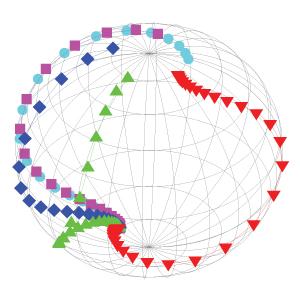Electronics: Magnetic memories on the right track

Pathways for the switching of a magnetic layer in an STT-MRAM device depend on the relative alignment of the two layers in the device. Copyright : 2014 A*STAR Institute of High Performance Computing
Computer hard drives store data by writing magnetic information onto their surfaces. In the future, magnetic effects may also be used to improve active memory in computers, potentially eliminating the need to ‘boot up’ a computer. One way to achieve this is through a memory technology known as STT-MRAM that utilizes information stored in a pair of thin magnetic layers.
By performing calculations, Chee Kwan Gan and colleagues from the A*STAR Institute of High Performance Computing have proposed ways to improve STT-MRAM memory through identifying design options for achieving faster switching speeds, and hence faster data write times [1].
In STT-MRAM devices, the relative orientation of the magnetic fields in the two thin layers determines the electrical resistance experienced by a current flowing through the device. If the magnetizations of both layers are aligned in the same direction, then the electrical resistance will be lower than when the layers have different magnetic alignments.
Switching the device between different magnetic states — which corresponds to writing information into the memory — is achieved by electrons whose magnetic property, the spin, is aligned in one direction. Collectively, these electrons are able to change the direction of the magnetization in one of the layers. The time it takes to switch the magnetic direction depends on several factors, including the initial relative orientation of the magnetic fields in the two layers. The magnetization of the switched layer can follow various complex paths during the switching process (see image).
In previous experiments, the switching process was found to depend on two parameters. Using their computational model, the researchers could focus on one parameter — the less-studied ‘field-like’ term — that accounts for the relative orientation of the magnetic fields in both layers. The strength of this term depends on various factors, such as the device geometry and the materials used.
The calculations by the researchers show that, for devices with a strong field-like term, there is greater potential to reduce switching times than for devices in which the field-like term is negligible. Gan explains that this discovery will assist the development of improved STT-MRAM devices. “Our findings will motivate experimentalists to fabricate devices with strong field-like terms,” says Gan.
Furthermore, a better understanding of the origin of the field-like term is needed, adds Gan. “Although the effect of the field-like term has been confirmed experimentally and investigated in this work through simulations, it is important to understand its physical origins in order to improve material design.”
Reference
1. Tiwari, R. K., Jhon, M. H., Ng, N., Srolovitz, D. J. & Gan, C. K. Current-induced switching of magnetic tunnel junctions: Effects of field-like spin-transfer torque, pinned-layer magnetization orientation, and temperature. Applied Physics Letters 104, 022413 (2014).
Media Contact
All latest news from the category: Physics and Astronomy
This area deals with the fundamental laws and building blocks of nature and how they interact, the properties and the behavior of matter, and research into space and time and their structures.
innovations-report provides in-depth reports and articles on subjects such as astrophysics, laser technologies, nuclear, quantum, particle and solid-state physics, nanotechnologies, planetary research and findings (Mars, Venus) and developments related to the Hubble Telescope.
Newest articles

A new look at the consequences of light pollution
GAME 2024 begins its experiments in eight countries. Can artificial light at night harm marine algae and impair their important functions for coastal ecosystems? This year’s project of the training…

Silicon Carbide Innovation Alliance to drive industrial-scale semiconductor work
Known for its ability to withstand extreme environments and high voltages, silicon carbide (SiC) is a semiconducting material made up of silicon and carbon atoms arranged into crystals that is…

New SPECT/CT technique shows impressive biomarker identification
…offers increased access for prostate cancer patients. A novel SPECT/CT acquisition method can accurately detect radiopharmaceutical biodistribution in a convenient manner for prostate cancer patients, opening the door for more…





















